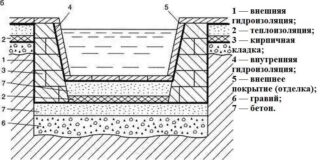The pool at the summer cottage is an excellent alternative to a natural lake or river. You can equip on your allotment both a stationary version and an inflatable one. The former are distinguished by their reliability and durability, but they require a lot of costs. For the second, only a pump and water are needed, but it has no other advantages.
- Choosing the right place for building a pool
- Preliminary design
- Varieties of pools for summer cottages
- Stationary
- Wireframe
- Inflatable
- Materials at hand
- Tools for the job
- Calculation of the required materials
- Stages of arrangement
- Preparation and digging of a pit
- Bowl concreting
- Construction of walls
- Waterproofing and finishing
- Care and maintenance tips
Choosing the right place for building a pool
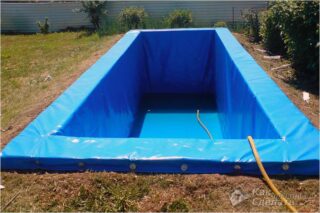
The choice is determined by many factors. If a full-fledged residential building is equipped on the site, the territory includes a vegetable garden, a garden, a recreation area, a playground and a bathhouse, it is preferable to build a capital structure. If the dacha is used only in summer, and the suburban area itself is not large, temporary inflatable pools are mounted.
For a stationary reservoir, you must choose the right place. Requirements:
- The pool evaporates a mass of water. In the middle of summer, this does not really matter, but in cool weather the reservoir provides a high level of humidity. Therefore, it is impossible to build it close to a residential building, garage, and other outbuildings. The minimum distance is 8 m.
- It is recommended to place the pond within sight of the house, especially if the family has children.
- For the tank, you need to choose a flat area without roots and holes. The distance to medium-sized trees should be 3 m, to tall trees - at least 5 m. Shrubs can be planted at a distance of 1–2 m.
- It is prohibited to install the structure next to the fence. Removal of at least 3 m.
- It is not allowed to build a homemade summer cottage pool on loose soil, next to a cliff, not far from highways or railways.
If the area is large enough, aesthetic criteria are taken into account. It is better to make a reservoir an element of an active recreation area. Decorating it, turning it into an analogue of a natural lake, is not worth it.
Preliminary design
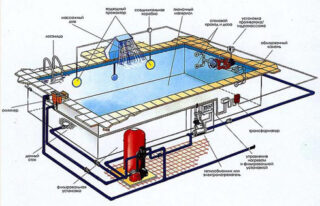
Do-it-yourself pool in the country is a complex design. In order for the water in an artificial reservoir to always be fresh and clean enough, it is necessary to plan the correct drainage and supply of water, purification of the liquid, the possibility of disinfecting procedures and much more.
The design of a reservoir includes several stages.
- Architectural - determine the size and shape of the bowl, the location of the pool. They think over a filtration system, plan the placement of service equipment. It is important to develop a general design, select materials for decoration and decor.
- Calculations - taking into account the peculiarities of the soil on the site and its relief, the pool design is chosen - frame, frameless. The type is determined by the parameters of the building material and the installation method.
- Structural - at this stage, the device of the supporting parts is being developed, the method of waterproofing, finishing, protection is chosen. The pool bowl is exposed to tremendous pressure, an error in the design stage leads to deformation of the bottom and walls.
- Design of communications - calculate the length and cross-section of the supply and discharge pipes, the power of the pumps, the filtration and power supply system.
The result of creating a sketch of a reservoir is a package of documents including drawings of the pool and all the main elements, a technical description of the units, an overview of installation recommendations, a list of materials. The list also includes an estimate of the work.
The project includes a survey and assessment of the selected installation site.
Varieties of pools for summer cottages
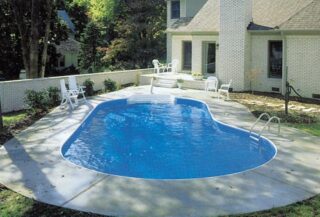
Before deciding how to make your pool, you need to choose its design and determine how many people will use it and for how long. There are stationary, frame and inflatable models.
Stationary
Such a structure with water heating can function all year round. The structure is heavy, very solid, made of concrete. It is allowed to install a thicket made of plastic: this option is cheaper, but not so durable and much more demanding on the quality of water.
The stationary pool is not cleaned for the winter, but is completely emptied. Such a structure is served by its own water supply, sewerage and purification system. From time to time during use, the pool must not only be cleaned, but also disinfected.
Wireframe
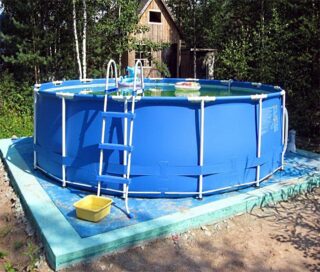
Collapsible design. The frame is the basis, on which a specially processed PVC fabric is pulled. Sizes and shapes are varied. The little ones do not need cleaning and even water circulation: in case of pollution, they simply scoop out the water and pour fresh water into the tank. If the reservoir is large, a water supply and drainage system is installed, as well as purification filters are installed.
Frame structures are easy to install and much cheaper than stationary ones. Minus: the service life is no more than 5-6 seasons.
Inflatable
The easiest option. The film bag is filled with air using a pump and is placed in any convenient place on a solid surface. It is recommended to make a concrete pad for it, but this is not necessary. Water is poured into the inflatable pool from a hose. The filtration system cannot be installed here, so cleaning and disinfection have to be done manually and a little more often. Usually inflatable models are not too big, so cleaning doesn't take long.
The pool in the courtyard of a private house can be made with your own hands from a variety of materials. Their size and functionality will not be as great as those of stationary counterparts, but mini-ponds will be able to please children and adults in the summer heat.
Materials at hand
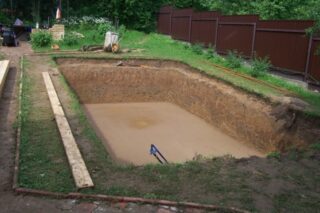
A common disadvantage of a temporary facility is the need for frequent water changes. If this does not frighten and the site is small, the option from scrap materials is quite suitable.
- The simplest option is a pit covered with a polypropylene film. A trench of the required depth and width is dug in any suitable area. The bottom is lined with construction cardboard so that it is softer to walk, the walls are closed with bags so that the film does not break. Then the pit is covered with a waterproofing film, and its edges are fixed with stones, at the same time finishing an artificial reservoir. The disadvantage of this solution is the limited size of the pond, since the film does not withstand high pressure.
- Frame version made of pallets - the pool bowl is constructed from 9 pallets, fastening them with slats and self-tapping screws. A pit for such a model is not needed, the reservoir is placed on a flat surface covered with a thick tarpaulin. From the inside, the "bowl" is covered with greenhouse film, and then with old bedspreads and blankets. This padding provides softness to the walls. At the last stage, the pool is sheathed with a waterproofing film of a bright color and glued to the sides with adhesive tape. Disadvantage: the size is small, and it will not last long.
- In addition to pallets, you can use old wooden or plastic boxes. They are assembled into a rectangular structure on rails and additionally wrapped around the perimeter with plastic tape. Install the pool onto a tarp or banner film. The disadvantages of the model are the same.
- An interesting idea is a hay pond.The bottom of the proposed reservoir is covered with hay, and the walls are built from dense hay bales. The structure is pulled together with belts, lined with cardboard or tarpaulin to prevent damage to the main film, and then covered with a waterproofing sheet. Such a pool can be quite large, but its depth is not great. Disadvantage: he is completely ugly.
A frame pool for a summer residence is also made by hand. The structure is welded from shaped pipes and lined from the inside with a waterproofing film. You can install such a reservoir on any level area.
There are other options, for example a children's pool can be made from a large car wheel.
Tools for the job
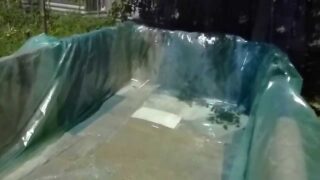
Materials and tools are selected based on the type of pool and construction. You will need:
- shovel, pickaxe, if it is supposed to dig a trench; if the pit is voluminous, you need to rent special equipment;
- frame material - pallets, boxes, metal pipes, reinforcement for a concrete bowl;
- tools for processing materials - a plane, a jigsaw, a hacksaw for metal, a saw, etc.
- measuring instruments - tape measure, plumb line, level;
- fasteners - screws, nails, metal corners, scotch tape, etc.
- waterproofing film;
- concrete, if a stationary pool is being built;
- finishing or cladding materials - paint, varnish, tiles:
- maintenance materials - pipes, nozzles, flanges, pump, skimmer or storage tank if the pool is drain.
Additional materials and equipment: concrete mixer, screwdriver, construction stapler, felt and so on.
Calculation of the required materials
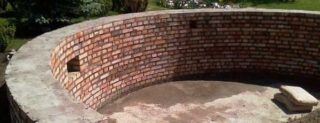
If we are talking about mini-ponds made of car tires or straw, you can handle the calculations yourself. If a concrete bowl is being erected, the calculations are much more complicated. It is better to entrust them to a specialist.
It is required to consider:
- The number of users. On average, swimming for 1 person requires a depth of 1.5 m and a pool length of 5 m. The more users, the larger the bowl. In this case, the depth remains unchanged. Although, at large sizes, it is recommended to make the reservoir multi-level.
- The deeper and more voluminous the bowl, the greater the volume of water presses on the bottom and, the thicker the walls of the pool should be. Calculate the value based on the strength indicators of the material used.
- The more complex the configuration of the reservoir, the more complex the calculations. The easiest way is to build a round or rectangular home pool.
- It is necessary to accurately determine the location of the incoming and outgoing pipes. If something was overlooked at the planning stage, holes for communications will have to be drilled in a concrete bowl, which is difficult and costly.
The structure of the pool and the thickness of the walls are also influenced by the nature of the soil, the level of groundwater, the relief of the site. Special knowledge is required to assess such factors.
Stages of arrangement
How to make a stationary pool with your own hands depends on its design. The walkthrough includes several required steps.
Preparation and digging of a pit
- It is better to dig a pit under the pool with an excavator.
- The walls of the pit are given a certain slope to prevent shedding of the earth. The bottom should also have an angle of inclination of 5–7% towards the place of water drainage. In the center of the bowl, additional insulation is dug under the drainage well.
- The well is covered with rubble and tamped. Then the design of the drain is determined.
- Place 20-30 cm of sand on the bottom, and then 10 cm of gravel. The sandy pillow is tamped.
Digging and preparation of the pit are performed only in dry weather.
Bowl concreting
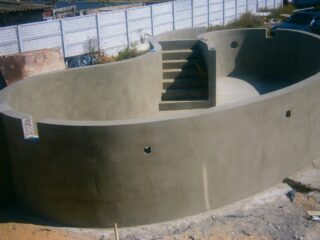
To fill the bowl, use a concrete mixture of the M400 grade or higher. You can make concrete yourself from crushed stone, cement, river sand and water.
- Concreting can be done in 2 stages or in 1. In the first case, a 5 cm thick screed is poured first. Then a frame is built and the next portion of concrete is poured. In fact, you can do it easier.
- A reinforcing frame is assembled from iron rods or wire with a diameter of 6–8 mm. The mesh size is 15–20 cm, the rods can be welded or fastened with a thin wire.
- The frame is placed on the bottom and walls on props made of brick or stone. There must be at least 5 cm between the ground and the reinforcement.
- Concrete is poured onto the bottom of the pit so that the material covers the bottom and reinforcement.
You can proceed to the next stage only after the concrete screed has completely dried.
Construction of walls
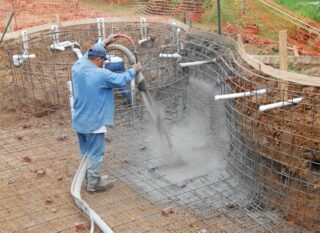
Before pouring concrete into the walls, it is necessary to lay inlet and outlet pipes or provide mounting holes for them. Also, the attachment points of any other formation are determined in advance. Step-by-step instructions:
- The formwork for the walls is made from boards with a thickness of 30 mm. Take a slab, unplaned boards, remnants of old structures.
- The formwork is reinforced with ribs from a bar with a section of 50 * 50 mm. The step between the ribs is 50 cm.
- If the project includes a concrete staircase to the pool, a separate formwork is made for it.
- The walls of the reservoir are subject to only slightly less stress than the bottom, so they also need to be reinforced. However, do this after pouring the first portion of the material. The reinforcement cage is immersed in the material while it has not yet hardened.
- The concrete is poured into the formwork in layers until it is completely filled.
The formwork can be removed after 4 days.
Waterproofing and finishing
After the concrete has completely dried, they begin finishing work.
- The reservoir is waterproofed. For this, roofing material, PVC membrane, bituminous mixtures, liquid rubber are suitable. It is recommended to sand the concrete surface before waterproofing, especially if using a liquid material.
- The quality of waterproofing is checked: the pool is filled with water and kept for 10-12 days. If the water level changes only by evaporation, the bowl is ready. If not, the waterproofing must be re-done.
- The walls and bottom of the pool are plastered. At this stage, filters are installed.
- Most often, an artificial reservoir is tiled. It is recommended to make wide joints between the tiles to compensate for deformation under water pressure. Mixes with high elasticity are used for grouting. The complex shape of the pool is decorated with mosaics.
- The sides of the reservoir and the near-water space are also decorated: they are laid out with tiles, stone.
For stationary pools, an overflow system is the best option. It allows you to clean the reservoir with minimal effort and is very economical: when there is no movement in it, clean water does not flow, when there is - dirty water splashes over the side of the pool, and clean water is supplied through the pipe.
Care and maintenance tips
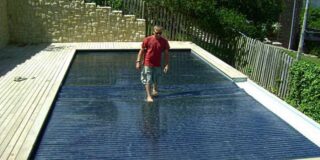
The rate of contamination of water in a pool depends on many factors. Therefore, the care procedures are carried out based on the water parameters. If the water becomes cloudy, let alone bloomed, urgent measures must be taken.
- Large floating debris is collected by hand. You can use a landing net.
- In a frame pool, if a skimmer filtration system is installed, debris is removed by connecting a filter pump.
- In large stationary reservoirs, underwater vacuum cleaners are used. The device sucks in debris and small organic particles that serve as a breeding ground for bacteria.
- If the water begins to bloom, they resort to disinfection. For this, various chemical agents are used: oxygen, bromine, chlorine. Coagulating agents give very quick results. It is allowed to use UV lamps and ionizers.
- Once a week - at least, the filters must be cleaned.
For the winter, the pool should be preserved: drain the water, treat the surfaces with disinfectants, refill and flush all the pool equipment using reverse flows.Then the water is drained again, the systems are repaired, and the bowl is covered with tarpaulin or polycarbonate.

